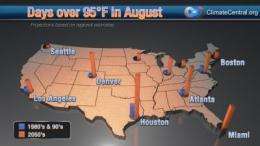Those dog days of August: 3 times the heat by 2050?

If you are wilting under the summer heat, consider this: your child may one day think of summer 2009 as "back in the cool old days." To illustrate expected increases in extreme summer heat, scientists at Climate Central have analyzed climate change projections made with global climate models.
Scientific literature based on these models anticipates much more frequent occurrences of hot days, "heat waves" (very high temperatures sustained over several days), and extremely warm summer seasons. Beyond being uncomfortable, these projected increases in extreme heat will have important societal impacts, including:
- heat stress mortality in humans and livestock;
- increases in peak energy demand;
- crop damage; and
- increased demand for water.
Climate Central's Associate Director for Strategic Initiatives, Dr. Ben Strauss, emphasizes that the numbers are not predictions. "We're talking about best estimates and averages," says Strauss. "No matter how close the projections turn out to be, some years will have more hot August days, and others will have fewer."
Climate Central is a nonprofit science and media organization created to provide clear and objective information about climate change and its potential solutions. Its work has appeared on PBS's The NewsHour with Jim Lehrer, TIME.com, newsweek.com, Scientific American, grist.org and beyond. Staff scientists drew on regional scenarios from a dozen highly sophisticated computer climate models to compare 1980 and 1990 averages with 2050 projections in three categories:
- Average number of days in August over 90.
- Average number of days in August over 95.
- Average number of days in August over 100.
Worldwide, since 1995, tens of thousands of people have died in heat waves. Other important impacts include increases in demand for energy (particularly electricity for cooling), and increases in urban and agricultural water demand.
The severity of increases in extreme heat and their impacts will depend on the extent of future use of fossil fuels. "We do have some choice here," says Dr. Berrien Moore III, Climate Central's Executive Director. "How hot it will get will depend on the choices we make about energy and transportation in the years to come."
More information: "Weather and Climate Extremes in a Changing Climate. Regions of Focus: North America, Hawaii, Caribbean, and U.S. Pacific Islands." U.S. Climate Change Science Program Synthesis and Assessment Product 3.3 (June 2008). Available at www.globalchange.gov/publicati … assessments/saps/300
Source: Climate Central














